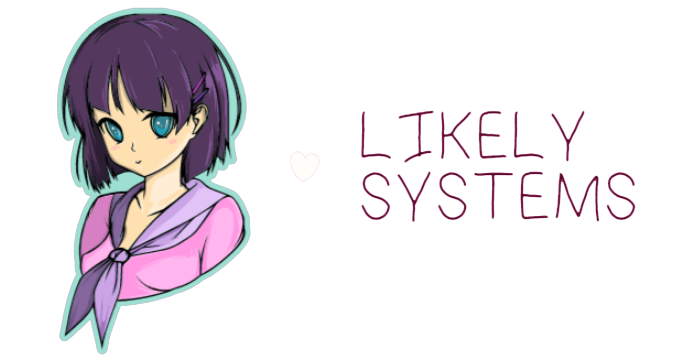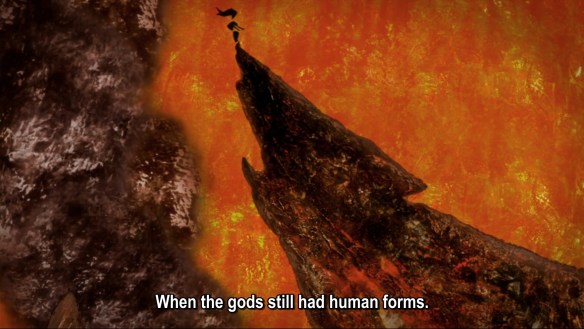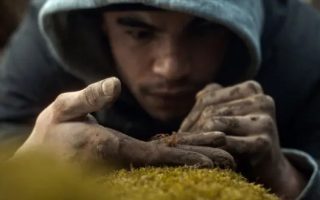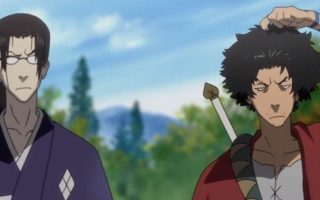Hello folks, and welcome back to Wrong Every Time. Today I’m thrilled to announce we’re embarking on a new adventure, as we explore the first episode of the ‘06 production Kemonozume. This series was actually the first TV production written and directed by Masaaki Yuasa, who has at this point proven himself not just anime royalty in his own right, but also one of the most important figures in the medium’s development across the 21st century.
Yuasa’s freewheeling visual style and piercing narratives have brought him international acclaim and legions of devotees, and his cofounding of Science SARU with Eunyong Choi resulted in a near-decade of legendary features, including series like Ping Pong the Animation and films like The Night is Short, Walk On Girl. From his directorial debut Mind Game through his Golden Globe-nominated Inu-Oh, Yuasa has built a canon that would be the envy of any director, and undoubtedly inspired a generation of similarly restless artists, people who wish to bring something genuinely new into the world.
I know little about Kemonozume specifically beyond the broad strokes of its premise: a violent love story in a world with shape-shifting carnivorous monsters. The fact that Yuasa both wrote and directed this one is pitch enough for me, particularly when he’s collaborating with regular character artist/animation director Nobutake Ito (Kaiba, The Tatami Galaxy, etc). After spending so much time appreciating Yuasa’s later work, I’m eager to see the distinct quirks of his first TV production, the apparent link between the ecstatic creativity of Mind Game and the honed thrust of Kaiba. Let’s get to it!
Episode 1
We open on an invocation of ancient times, “when the gods still had human forms.” Even this first composition demonstrates Yuasa’s fascination with distinct styles of visual storytelling; this mountaintop and skyline are painted like drawings on cave walls, the form echoing the narrative content. These simplified humanoid shapes are also quite Yuasa, as he consistently delights in reducing characters to loosely assembled geometric patterns, which is basically one of the essences of cartooning. And of course, there’s the ostentatious cel-merging effect making the blackness on the left appear like rising smoke – perhaps due to his rise through children’s animation, Yuasa is less afraid of ostentatious breaks in the holism of the animated frame (something clearly demonstrated through Mind Game’s mixed media approach)
A man kidnapped a woman about to be sacrificed to the gods. For this crime, the pair were turned into creatures that could only live on human flesh
Given his later productions, it’s hard to avoid seeing shades of Devilman in this premise. Then again, love is frequently tethered to ideas of physical destruction in fiction; both werewolf and vampire narratives tend to hinge on this fickle boundary line, echoing how love of the outsider was always considered a “monstrous” quality
Speaking of Yuasa’s confidence with mixed media, our transition from this ancient story to the present time is accompanied with color-filtered live action photography, a trick he would reuse for The Tatami Galaxy. Aesthetic holism is a fine feat to strive for, but it’s not the only valid method!
Then we’ve got our OP, which is unsurprisingly pure Yuasa as well. The man has the greatest OP hit rate of basically any director, a feat which comes down to a variety of clear choices: the care with which he selects emotionally appropriate music (genre, tempo, lyrics, tone), the fluidity and precision of imagery he employs, and the absolute Fantasia-esque unity of rhythm and intent tethering song and images together. “Animating to music” is a distinct skill in its own right, one Yuasa has excelled at from his days on Mariko-chan through the musical interludes of his recent Inu-Oh
Recurring stylistic quirks are swiftly evident: his fondness for matching beats to added screen partitions (a trick also employed by The Tatami Galaxy’s OP), silhouettes performing before block colors (Kaiba, Devilman Crybaby), superdeformed shapes whose forms embody their current actions (practically everywhere in his career, including the cuts he animated for the marijuana fields fight in Samurai Champloo)
As for the song, a panicked, propulsive jazz number feels eminently appropriate for a twisted mafia love story
Our first shot of the show proper continues this mixed media approach, with the fishes in the foreground seemingly possessing rotoscoped bodies textured over with pattern-painted skin, while loosely drawn humans lounge in the background. The shot offers a sense of unity between these forces and also entrapment, framing them as fellow prisoners within a great glass cage
One of our two speakers says he “only eats cute girls.” The link between sex and physical consumption immediately established
Some of these fish tank cuts are also just altered real life footage. Don’t feel restricted by convention!
The character art is loose, but the character acting is vividly clear. Something Kaiba embodies – the essence of human emotion is not contained in our precise physical forms, but in how we move, regardless of our bodies
“My women won’t say anything, or rather, can’t.” The line is intentionally blurred between conventional misogynist abuse and literally devouring women, inviting us to ask how much distance separates the two, and the true nature of what society considers acceptable gender discourse. For as much as Yuasa is a genius of aesthetics, his work wouldn’t resonate with me if he weren’t also deeply invested in engaging with the world around him, in telling stories that dig deep into human nature or puncture the affectations of society’s villains
As the predator rants about his bloody passions, his companion only sighs and lightly admonishes his enthusiasm
Delightful looseness of forms as his buddy retreats and these monster-hunting samurai attack. Ecstatic action in Yuasa productions is often illustrated through wild, low-frame transitions between greatly exaggerated poses, as if the bodies themselves are warping with the intensity of the action
It’s actually an effect I’ve seen recently in The Fire Hunter, and would be happy to see more of. Unfortunately, modern audiences clearly prefer the CG-assisted quasi-realistic solidity of much modern shonen; basically “the Ufotable look,” an aesthetic I have at this point lost all patience for
One swordsman loses his nerve in battle, flashing back to a woman who introduces herself as “his new mother.” Between that and the later call to become a “great swordsman of the Kifuuken,” it seems likely this man was adopted into a clan of warriors
An older swordsman is tended to by Rie, a young woman who is also attached to this order
It seems Toshihiko is the name of our reluctant swordsman
Love the distinctive head shapes of these various swordsmen. Yuasa quite likes the “gopher cheeks face” of the guy on the right, he’s used it a few times in his career
This meeting is an easy way to catch the audience up to speed on these monsters. We learn that a second type of Flesh Eater has recently appeared, one much more like a human even in their true form
The silver-haired swordsman recommends a new approach for a new age, a Buster Suit that will help them wipe out all Flesh Eaters
Apparently “Kemonozume” is the special attack employed by these Kifuuken
A generational conflict, tradition versus innovation, but with the added complication of this silver-haired descendant’s capitalist ambitions. Is the old man wrong to value the clan’s honor so highly, or is the young man Kazuma wrong to see this crisis as an opportunity?
I appreciate this quick cut to those waiting in the hallway, bearing the weight of the clan’s increasing dissolution
Yuasa can’t help his scatological fascinations. Even this contrast between brothers hinges partially on Toshihiko’s upset stomach
The father’s destroyed arms point to towards the decay of this family, and its increasing reliance on creaky technology
“Are you going to treat me like a stepchild again!?” Legacy clearly weighs heavily on this whole family
Kazuma vows to defeat the Flesh Eaters in his own way before storming out. The harsh dutch angles and wobbling, inconsistent horizon lines of these compositions emphasize the dissolution of the house, like the building itself is warping and collapsing in response to the brothers’ feud. Granted, this is all of a piece with Yuasa’s general approach to modern settings; he employs similarly warped geography and loosely painted backgrounds for shows like The Tatami Galaxy and Ping Pong. Whether a drawing feels “alive” to him is clearly far more important than whether it feels realistic, and I tend to agree
Toshihiko takes a walk on the beach after the meeting, and Rie attempts to cheer him up. None of these characters seem to possess a real sense of urgency beyond Kazuma, making me wonder as to the actual scale of the threat
Rie attempts to grab his hand, but Toshihiko is too wrapped up in his failures for such things, and likely considers himself unworthy of returning her affections
Ooh, I really like how we montage through all our leads as we march through the end of this long night. There’s a languorous, temporal quality to all of this that makes it all feel a bit film noir, even setting aside the saxophone riff. Part of the story here is simply getting through the days, suffering through this fallen world
Yuasa loves his weird creatures. The morning introduces us to a monkey who’s pretty much the Science Saru mascot
Toshihiko’s practice demonstrates his genuine agility, once more through some frame-low but pose-rich distorted cuts
“This sword technique isn’t meant to kill monsters. Its true goal is to contain the evil within your own heart.” Toshihiko’s interpretation of their clan name already pointing towards his misgivings regarding their mission, and his feelings of equivalence between the swordsmen and the monsters they slay
“The true son who carries his father’s blood will be the heir!” Kazuma makes Toshihiko’s lineage explicit as they prepare for their duel. In spite of the interludes, we’re wasting no time this episode, swiftly establishing and then complicating this world’s relationships
The monkey just totally demolishes Kazuma, which Toshihiko takes as a kind of portent
His chase leads him to the beach, where he runs into a skydiving woman who reminds him of his adopted mother
His utter fascination is easily conveyed through this extended cut following her shifting expressions, accompanied by a horn solo that feels playful and effervescent. Evidently you don’t need total fluidity of animation to convey that moment of being starstruck by beauty
Another lovely trick of the camera holding this particular frame even as she walks away and gets into a car, emphasizing how he couldn’t look away from her face
Her face is now superimposed over everyone he interacts with, destroying his clarity as a swordsman
The beach is clearly a testing ground for many of Yuasa’s ambitious visual flourishes, like this distinctive colored lighting effect that contributes to a superflat, depth-averse composition while echoing the glowing reflected-on-aluminum effect of old cel animation. As this production demonstrates, Yuasa was quick to adopt to the opportunities afforded by digital animation, a quality that likely informed Science Saru’s consistent experimentation with Flash animation techniques
The two meet in the rain and make love beneath stormy skies, the passion briefly igniting her Flesh Eater nature
And Done
Whew, that was a terrific premiere! Efficient, engaging, and a dynamite demonstration of Yuasa’s visual sensibilities, with character art, animation, and background design all echoing preferences and techniques exhibited throughout his catalog. Yuasa and Ito are clearly kindred souls, and this early in his directorial career, it’s also clear he’s still reveling in the mixed media freedom embodied by Mind Game. And all that luscious art design is working in service of a story that feels propulsive and pointed, mixing classic tropes of martial inheritance with a focus on gender and identity on the battlefield of our modern social climate. It’s almost a bittersweet feeling to finally dig into this last outstanding early Yuasa production, but its flesh is delicious indeed, and I’m looking forward to devouring it with reckless abandon!
This article was made possible by reader support. Thank you all for all that you do.




